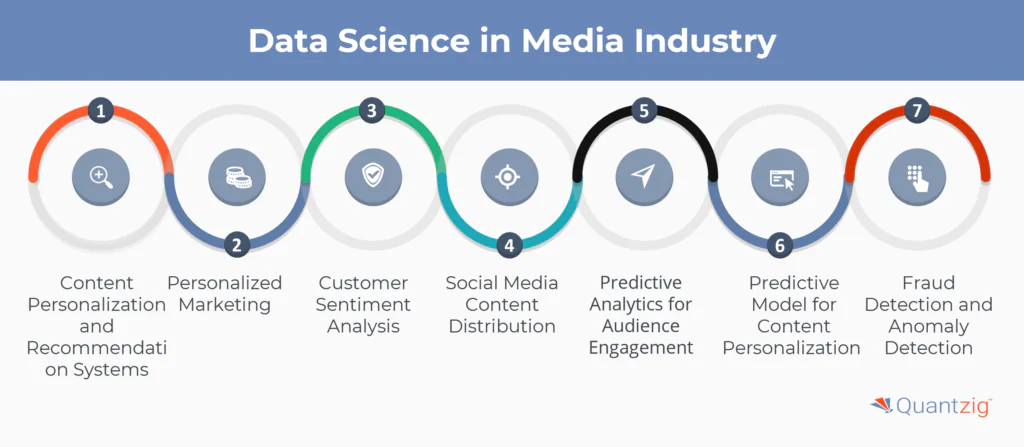Written By: Sudeshna Ghosh
Table of Contents
Table of Contents
- Introduction to Data Science in Media
- What is Data Science?
- Understanding Data Science in the Entertainment Industry
- Data Science Use Cases in Media and Entertainment Industry
- Other Data Science Use Cases
- Conclusion
Introduction to Data Science in Media
Data Science is a multifaceted and fast-growing field of study used in a wide range of applications that provide better business value and insights in the enterprise. It uses a variety of advanced analytics techniques and predictive modeling algorithms that aims to derive meaningful insights from data visualization to address strategic business or scientific inquiries. This comprehensive understanding empowers companies to tailor customized marketing strategies, discern customer sentiment, and optimize content for maximal resonance. Real-time analytics offer timely updates on audience engagement metrics, while recommendation engines deftly guide users towards relevant content offerings.
Leveraging Quantzig’s cutting-edge data analytics solutions, businesses can enhance customer lifetime value and purchases, fortify profitability, and navigate the competitive landscape with precision. Our data analytics dashboard solution offers a comprehensive and intuitive platform designed to empower businesses across industries to harness the full potential of their data.
Request a demo to experience the meaningful insights we derive from data through our analytical tools and platform capabilities. Schedule a demo today!
Request a Free DemoWhat is Data Science?
Data Science is a transformative field that leverages technology and innovation to drive advancements in various sectors, including the entertainment industry. By employing artificial intelligence and machine learning, data scientists can analyze vast amounts of data to improve marketing strategies, enhance audience engagement, and boost revenue generation. Effective data collection and the mitigation of analysis biases ensure accurate insights, which are critical for identifying target audiences and improving conversion rates. Ultimately, the application of data science leads to higher customer satisfaction and better return on investment for businesses.
Understanding Data Science in the Entertainment Industry
Data science has become a critical component in the entertainment industry, transforming how companies make decisions, create content, and engage with audiences. Entertainment organizations are leveraging advanced analytics, machine learning, and artificial intelligence to gain unprecedented insights and drive strategic business outcomes, such as content personalization and recommendation systems, optimizing content creation and distribution, and fraud detection and anomaly analysis. The integration of data science has enabled entertainment companies to better understand their audiences, create more engaging content, and optimize their operations, leading to increased profitability and a competitive edge in an increasingly crowded market.
Data Science Use Cases in Media and Entertainment Industry
In the digital age, where data is the new currency, the media and entertainment industry are undergoing a profound transformation fueled by the adoption of data science. From content creation to audience engagement, data science in media industry is playing a pivotal role in reshaping how companies in this sector operate and innovate. Let’s delve into three compelling use cases that showcase the transformative power of data science in the media and entertainment landscape.
1. Content Personalization and Recommendation Systems
One of the most prominent applications of data visualization and data science in the media and entertainment industry is the creation of advanced content personalization and recommendation systems. With vast amounts of data visualization generated by user interactions, viewing preferences, and engagement patterns, media companies can leverage sophisticated algorithms to tailor content recommendations to individual users.
For instance, streaming platforms analyze user behavior, such as the genres they frequently explore, watch history, and time spent on specific content. Advanced machine learning models process this data to predict user preferences accurately. The result is a personalized content recommendation engine that not only enhances user satisfaction but also maximizes content consumption, ultimately driving revenue through increased subscriptions and ad views.
2. Personalized Marketing
For example, media and entertainment companies, attracting customers’ attention becomes an important prerogative, especially when consumers expect quick and impressive online experiences. This is where personalized marketing algorithms come to the rescue. Such algorithms can recognize existing and new customers and extract out valuable information in real-time. Also, these algorithms can help companies to perform cross-channel tracking, performance, and tailoring personalized offers and messages based on behavioral insights. This can further help in influencing and retaining a potential group of customers.
3. Customer Sentiment Analysis
Media and entertainment companies must analyze the sentiments of their customer groups. Customer sentiment classification analysis uses advanced algorithms and machine learning techniques to analyze textual conversations and classifying posts, and messages based on the emotions hidden behind the context. This can help data science media and entertainment companies to increase positive mentions of their names and improve brand image while also maintaining the customer lifetime value.
4. Social Media Content Distribution
Social media content distribution plays a key role in enforcing suitable marketing strategies today. Content distribution mostly depends on the analysis of social media statistics that comprises data of user behavior, experience, and interests. With the application of algorithms, companies can identify the target readers and relevant marketing channels to drive growth. Content distribution on social media platforms can be successful only when it is well organized, prepared, targeted, relevant, flexible, and gradual.
5. Predictive Analytics for Audience Engagement
Data science empowers media and entertainment companies to anticipate audience behavior and tailor engagement strategies accordingly. Predictive analytics models analyze historical data, social media trends, and viewer interactions to forecast audience preferences, content demand, and even potential market trends.
By understanding what audiences are likely to engage with in the future, companies can optimize their content creation strategies, marketing campaigns, and scheduling. This proactive approach not only enhances the quality of content but also enables effective resource allocation and marketing budget optimization. For examples, predicting the popularity of specific genres or themes allows content creators to focus efforts on producing content with a higher probability of success.
6. Predictive Modeling for Content Personalization
In the dynamic world of the media and entertainment industry, predictive modeling emerges as a powerful tool for content personalization, catering to diverse audience preferences. Leveraging natural language processing and sentiment analysis, data scientists can analyze vast datasets encompassing viewer interactions, feedback, and social media sentiments. By employing recommendation systems, predictive algorithms steps, media companies can anticipate viewer preferences, monitor product performance, enhance product development, optimize content offerings, and enhance engagement metrics. This approach not only bolsters customer satisfaction but also fosters brand loyalty in an increasingly competitive market.
7. Fraud Detection and Anomaly Detection in Digital Distribution Platforms
In the field of digital distribution platforms, safeguarding against fraudulent activities and anomalies is paramount to maintaining trust and integrity. Through sophisticated fraud detection algorithms and anomaly detection techniques, data scientists can meticulously analyze transactional data, user behavior, and network activities. By implementing social network analysis and machine learning models, anomalies indicative of fraudulent activities can be swiftly identified and addressed. This proactive approach not only safeguards the platform’s integrity but also fortifies customer trust, ultimately driving sustainable growth and profitability in the digital entertainment landscape.
Experience the advantages firsthand by testing a customized complimentary pilot designed to address your specific data statistics requirements. Pilot studies are non-committal in nature.
Request a Free PilotOther Data Science Use Cases
In today’s rapidly evolving digital landscape, data science stands at the forefront of innovation for many companies, driving transformative changes across industries. Leveraging advanced technologies and analytical techniques, data scientists unlock valuable insights from vast troves of data, empowering businesses to reach to their goals, make informed decisions and optimize their operations. From fraud detection in banking to customer churn prediction in telecom, data science applications span a myriad of use cases, each harnessing the power of predictive modeling, market basket analysis, text mining, credit risk modeling, natural language processing, and other cutting-edge tools. Here are some other Data Science Use Cases:
1. Predictive Analytics in Healthcare
Data science can be used in healthcare to analyze patient data and improve treatment outcomes. Predictive modeling has become a cornerstone in healthcare, leveraging natural language processing to analyze vast volumes of unstructured medical data. This aids in fraud detection within insurance claims and enhances customer segmentation for targeted healthcare services. Moreover, time series analysis enables the prediction of patient outcomes and disease progression, while image recognition facilitates early detection of anomalies in medical imaging.
Anomaly detection algorithms in time series analysis flag irregularities in patient data, assisting in proactive interventions of diseases. Demand forecasting predicts medical resource utilization, optimizing supply chain operations. Social network analysis identifies influential factors in public health trends, aiding churn prediction for healthcare plans. Market basket analysis unveils patterns in treatment combinations, guiding credit risk modeling for healthcare financing. Customer lifetime value estimation aids in personalized patient care strategies. Text mining extracts insights from medical literature, contributing to evidence-based medicine.
Through these data science applications, healthcare providers or people can make informed decisions to improve patient outcomes, reduce costs, and drive operational efficiency in a rapidly evolving healthcare landscape.
2. Fraud Detection and Prevention in Banking
Financial institutions leverage data science for risk assessment and portfolio management. Predictive modeling, employing advanced algorithms, is pivotal in thwarting fraudulent activities within banking systems. Natural language processing techniques help in scrutinizing transaction details, datasets and customer communications, identifying potential anomalies. This amalgamation of technology and expertise refines customer segmentation, enabling tailored interventions for high-risk accounts. Time series analysis offers insights into evolving fraud tactics, allowing preemptive action. Image recognition verifies identity documents, bolstering security. Anomaly detection algorithms continuously monitor transactions, flagging irregularities for investigation, fortifying fraud prevention efforts.
3. Recommendation Engines in E-commerce
Sentiment analysis-driven recommendation engines sift through social media sentiments, statistics and datasets, tailoring product recommendations to individual preferences. This empowers e-commerce platforms to provide personalized experiences, enhancing customer satisfaction and driving sales. Leveraging natural language processing, these engines analyze customer feedback and reviews, discerning sentiment classification and preferences. By harnessing these insights, e-commerce businesses optimize product offerings, prices, and marketing strategies, fostering customer loyalty and revenue growth.
4. Sentiment Analysis in Social Media
Social media sentiment analysis enables businesses to gauge public opinion and brand perception, guiding strategic decision-making. Leveraging natural language processing, sentiment classification analysis algorithms decipher social media conversations, discerning positive, negative, or neutral sentiment towards brands, products, or topics. By monitoring social media sentiment, businesses can promptly address issues, focus on most critical areas, capitalize on positive feedback, and tailor marketing campaigns to resonate with their target audience. This proactive approach enhances brand reputation, fosters customer engagement, and drives business success.
5. Supply Chain Optimization
Supply chain optimization tools leverage data analysis to streamline logistics operations, enhance efficiency, and reduce costs. By analyzing historical and real-time data, these tools identify inefficiencies, optimize inventory levels, and improve distribution routes. Predictive modeling forecasts demand fluctuations, enabling proactive inventory management and reducing stockouts or overstock situations. Additionally, natural language processing facilitates insights from unstructured data sources, such as customer feedback or supplier communications, aiding in decision-making processes. Through supply chain optimization, businesses can enhance operational agility, responsiveness, and customer satisfaction, ultimately gaining a competitive edge and standing out from competitors in the market.
6. Customer Churn Prediction in Telecom Industry
Customer churn prediction models employ predictive analytics to identify subscribers for companies at risk of switching providers. By analyzing customer usage patterns, billing history, and demographic data, these models forecast churn probabilities, enabling targeted retention strategies and competitors analysis. Leveraging natural language processing, telecom companies analyze customer feedback and interactions, extracting insights to enhance service offerings and address pain points. Through proactive pricing churn management and text mining telecom operators reduce customer attrition, foster loyalty, and maximize revenue.
7. Demand Forecasting in Retail
Retail companies use data science and social network analysis to optimize pricing strategies, study competitors and recommend personalized products. Demand forecasting using data science applications in retail utilizes predictive analytics to anticipate consumer demand for products and optimize inventory levels accordingly. By analyzing historical sales data, market trends, and external factors, retailers forecast future demand with accuracy. Natural language processing techniques extract insights from customer reviews, social media, and market research reports, providing valuable input for forecasting models. Armed with reliable demand forecasts, retailers optimize product prices in groups, stocking levels, minimize stockouts, and reduce excess inventory costs. This enables retailers to meet customer expectations, do proper pricing, enhance profitability, and maintain a competitive edge in the market.
8. Image Recognition and Object Detection
Image recognition and object detection technologies utilize deep learning algorithms to identify and classify objects within images or videos. These technologies find applications across various industries, including security, healthcare, automotive, and retail. In security systems, image recognition aids in facial recognition, access control, and surveillance. In healthcare, market basket analysis assists in medical imaging analysis, disease diagnosis, and surgical planning. In retail, it enables visual search capabilities, product recommendations, and inventory management. Leveraging image recognition and object detection, businesses automate processes, improve decision-making, and enhance customer experiences, driving operational efficiency and innovation.
9. Natural Language Processing Applications
Natural language processing (NLP) applications encompass a wide range of tools and techniques like credit risk modeling that enable computers to understand, interpret, and generate human language. These applications find diverse applications across industries, including healthcare, finance, customer service, and marketing. In healthcare, NLP with ai facilitates clinical documentation, medical coding, and patient engagement through virtual assistants. In finance, it automates document processing, sentiment analysis, and fraud detection in banking transactions. In customer service, chatbots powered by NLP provide personalized assistance and streamline support operations. In marketing, NLP analyzes customer feedback, sentiment, and trends to inform marketing strategies and campaign optimization. By harnessing NLP applications on devices, businesses improve efficiency, enhance their decision-making goal, get desired results, and deliver enhanced customer experiences in groups.
Experience the advantages firsthand by testing a customized complimentary pilot designed to address your specific requirements. Pilot studies are non-committal in nature.
Request a Free PilotConclusion
In conclusion, in the dynamic world of the media and entertainment industry, data science’s goal emerges as a game-changer, offering unparalleled opportunities and results for innovation and audience engagement. The use cases mentioned—content personalization, predictive analytics for audience engagement, and sentiment analysis—underscore how leveraging data science media can not only drive operational efficiency but also fundamentally reshape the ways content is created, distributed, and consumed.
As the ways of data science media continues to evolve, media and entertainment companies that embrace its capabilities will gain a competitive edge. The ability to harness data-driven insights not only enhances the bottom line but also gives ways to attain positions for these companies at the forefront of an industry where understanding and meeting audience expectations is paramount.
Get started with your complimentary trial today and delve into our platform without any obligations. Explore our wide range of customized, consumption driven analytical solutions services built across the analytical maturity levels.
Start your Free Trial Today






